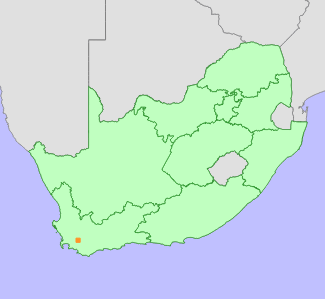|
Scientific Name | Prismatocarpus lycioides Adamson |
Higher Classification | Dicotyledons |
Family | CAMPANULACEAE |
National Status |
Status and Criteria | Critically Endangered B1ab(iii,v); C2a(i,ii); D |
Assessment Date | 2015/07/13 |
Assessor(s) | C.N. Cupido, D. van der Colff & L. von Staden |
Justification | Known from a single remaining subpopulation of about 50 mature individuals, and declining due to ongoing habitat degradation. It has a limited historical distribution range of <30 km². Suitable habitat still remains in this area, but searches for more subpopulations have thus far been unsuccessful. |
Distribution |
Endemism | South African endemic |
Provincial distribution | Western Cape |
Range | Doring and Modder River valleys south of Worcester. |
Habitat and Ecology |
Major system | Terrestrial |
Major habitats | Breede Shale Renosterveld, Breede Quartzite Fynbos |
Description | Transitional fynbos-renosterveld on quartz bands at the foot of south-facing slopes of low shale hills. |
Threats |
| This species may already be locally extinct due to habitat loss to vineyards at the type locality. The two river valleys where it is known from are extensively converted to vineyards, and loss is ongoing. One known remaining subpopulation is declining due to ongoing habitat degradation. Livestock is grazing the site, and it has not burnt in a very long time. Many fynbos species are dependent on fire for regeneration. Alien invasive plants are currently present in low densities at the site, and need to be managed to avoid it becoming a threat to this species in future. |
Population |
This species was previously known from a single locality in the Doorn River Valley between Worcester and Villiersdorp, where it was last collected in 1940. At least five visits to this locality over the past five years have failed to relocate the subpopulation (C.N. Cupido pers. comm. 2015). Most of this farm is under vineyards, and it is possibly already locally extinct. A small chance remains that it may still be relocated on the foot slopes of the Hammansberg, north of this farm. In 2008, a small subpopulation numbering about 50 individuals was discovered on a farm about 10 kilometres north of this locality. Monitoring of this population over the past few years has recorded ongoing decline, possibly due to a lack of fire and grazing, as well as poor recruitment (C.N. Cupido pers. comm.). Several other trips to this area in search of this species have thus far failed to locate any other surviving subpopulations. It appears to be a rare, localized habitat specialist.
|
Population trend | Decreasing |
Conservation |
| Not currently conserved in any formally protected area. |
Assessment History |
Taxon assessed |
Status and Criteria |
Citation/Red List version | | Prismatocarpus lycioides Adamson | CR B1ab(iii,v); C2a(i,ii); D | 2015.1 | | Prismatocarpus lycioides Adamson | Data Deficient | Raimondo et al. (2009) | | Prismatocarpus lycioides Adamson | Lower Risk - Least Concern | Victor (2002) | | Prismatocarpus lycioides Adamson | Insufficiently Known | Hilton-Taylor (1996) | |
Bibliography |
Adamson, R.S. 1951. A revision of the genera Prismatocarpus and Roella. Journal of South African Botany 17:93-166.
Goldblatt, P. and Manning, J.C. 2000. Cape Plants: A conspectus of the Cape Flora of South Africa. Strelitzia 9. National Botanical Institute, Cape Town.
Hilton-Taylor, C. 1996. Red data list of southern African plants. Strelitzia 4. South African National Botanical Institute, Pretoria.
Raimondo, D., von Staden, L., Foden, W., Victor, J.E., Helme, N.A., Turner, R.C., Kamundi, D.A. and Manyama, P.A. 2009. Red List of South African Plants. Strelitzia 25. South African National Biodiversity Institute, Pretoria.
Victor, J.E. 2002. South Africa. In: J.S. Golding (ed), Southern African plant Red Data Lists. Southern African Botanical Diversity Network Report 14 (pp. 93-120), SABONET, Pretoria.
|
Citation |
| Cupido, C.N., van der Colff, D. & von Staden, L. 2015. Prismatocarpus lycioides Adamson. National Assessment: Red List of South African Plants version 2024.1. Accessed on 2025/11/25 |
 Comment on this assessment
Comment on this assessment


